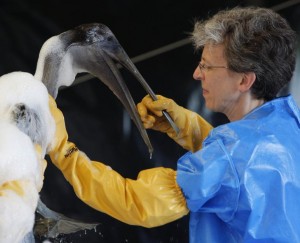My Hero This Week Isn’t Thinking About Horses; She Has Oily Birds on Her Mind
- March 10, 2017
- ⎯ Fran Jurga

Dr. Heather Nevill washed a brown pelican at Fort Jackson Wildlife Rehabilitation Center in Buras, Louisiana last week. The oil-soiled bird was one of eight rescued off the coast of Louisiana during massive wildlife triage efforts in the face of the approaching oil from the BP well explosion in the Gulf of Mexico. Dr Nevill is Associate Professor of Small Animal Medicine and Surgery at Western University of Health Sciences and Clinical Veterinarian and Research Coordinator at the International Bird Rescue Research Center in California; IBRRC is the world’s preeminent expert agency on rehabilitation for seabirds and waterfowl. They are who you call when you have an oil spill, if you care about the birds. Dr Nevill’s role is especially poignant since she is a native of Louisiana. Photo: REUTERS/Hans Deryk courtesy of fOTOGLIF.
From the IBRRC Facebook page, which has turned into a daily diary of the crew’s work on-site in Louisiana, Dr Nevill wrote:
“The days are starting to blend together here. It’s really good that I have the day of the week on my little digital watch, or else I wouldn’t have realized that Monday has come again. We have two clean Louisiana brown pelicans in house, one adult and one juvenile. They’re both female and tiny, and they seem to love the little silversides we’re feeding them. A clean laughing gull shares the 8′ x 24′ aviary with them, and despite the small size of the pen he flies around all the time.
“The young pelican is the one whose pictures were all over the news two days ago…The wash was even more exciting because Secretary Ken Salazar (Department of the Interior) was here for the beginning of it. He asked great questions and was very engaged. And he didn’t seem offended when the pelican barfed up the fish she’d eaten the night before. Trust me, the rest of us noticed the awful smell. Too bad the press didn’t get THAT on camera!
“Please wish us continued good luck in getting these amazing birds clean and waterproof.”
As I was watching this video–which is just raw footage, there is no narration–I kept wondering what will happen to this pelican. When and if he is released back into the wild, will there be anything for him to eat? That’s Secretary Salazar in the oilskin apron and ballcap, by the way, in case you don’t recognize him. His name often appears in this blog related to matters pertaining to wild horse management. I wonder if he’d have an answer to that question.
As you watch this and any video and on some images on The Jurga Report that is imported from YouTube.com and some other host sites, it is possible that advertising will be embedded in the bottom of the screen or even in the video itself. This advertising has nothing to with this blog or with equisearch.com and there is nothing I can do to get rid of it. You can click on the little “x” at the top right of the ad box and it should go away. I’m sorry it’s there; it annoys me too, but it is the cost of “free”, if you know what I mean.
by Fran Jurga | 28 May 2010 | The Jurga Report at Equisearch.com Follow @FranJurga on Twitter.com for more horse health news!










